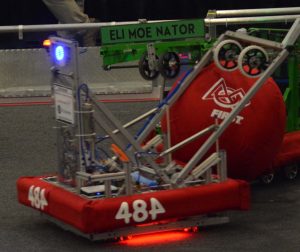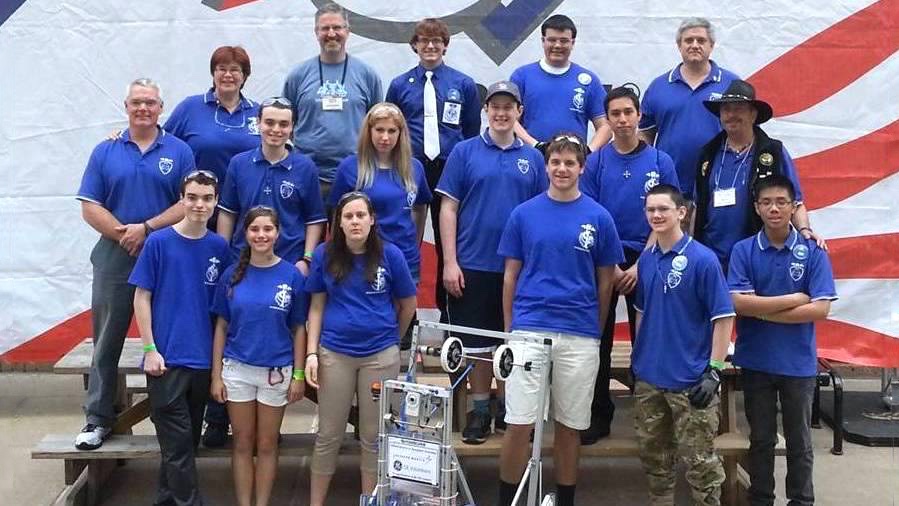 Fluffy, named after the lovable 3-headed dog from Harry Potter, was team 484’s 2014 robot and the robot, that introduced the team to the FRC world championship in St. Louis. The robot utilized a drivetrain known as machanum: a holonomic drive system that consists of 4 wheels with specially designed, diagonal rollers on them which allows the robot to drive sideways, in addition to forward, backwards, and turning. Besides the drivetrain, the robot consisted of 2 primary systems, a pickup and a shooter. The pickup system consisted of a pneumatically actuated arm with wheels on it. The wheels would pull the ball into the robot over the rear bumpers. Once in the robot, the shooter could then shoot the ball into the goal. The shooter used a catapult system, actuated with pneumatics. By changing the duration the pneumatics were filled with air for, the speed of the shot could be varied. In the event that the ball needed to be ejected out of the bot, either into another robot or into the low goal, the robot also featured a “kicker” that would push the ball out the back. The robot was also the first one to attempt the use of vision processing which could determine (most of the time) when the high goal was “hot” in autonomous. Each of the 2 high goals were got for 1/2 of the autonomous period and shooting in a high goal while hot gave twice the number of points. Points were also earned by having each of the three robots on the alliance have possession of the ball at some point during a cycle. This is where the kicker helped tremendously, allowing the team to quickly give the ball to the next robot on the alliance.
Fluffy, named after the lovable 3-headed dog from Harry Potter, was team 484’s 2014 robot and the robot, that introduced the team to the FRC world championship in St. Louis. The robot utilized a drivetrain known as machanum: a holonomic drive system that consists of 4 wheels with specially designed, diagonal rollers on them which allows the robot to drive sideways, in addition to forward, backwards, and turning. Besides the drivetrain, the robot consisted of 2 primary systems, a pickup and a shooter. The pickup system consisted of a pneumatically actuated arm with wheels on it. The wheels would pull the ball into the robot over the rear bumpers. Once in the robot, the shooter could then shoot the ball into the goal. The shooter used a catapult system, actuated with pneumatics. By changing the duration the pneumatics were filled with air for, the speed of the shot could be varied. In the event that the ball needed to be ejected out of the bot, either into another robot or into the low goal, the robot also featured a “kicker” that would push the ball out the back. The robot was also the first one to attempt the use of vision processing which could determine (most of the time) when the high goal was “hot” in autonomous. Each of the 2 high goals were got for 1/2 of the autonomous period and shooting in a high goal while hot gave twice the number of points. Points were also earned by having each of the three robots on the alliance have possession of the ball at some point during a cycle. This is where the kicker helped tremendously, allowing the team to quickly give the ball to the next robot on the alliance.
Aerial Assist was the 2014 FRC Challenge. In this challenge, 2 alliances of 3 robots raced to score 2-foot-diameter exercise balls into goals positioned one their alliance’s side of the field. During the process, 10 points would be awarded for each robot that had possession of the ball, and an additional 10 points would be awarded if the ball was shot over a truss positioned in the center of the field and another 10 if that ball was caught by a robot while going over the truss. The goals available to score in consisted of a pair of high goals and low goals. The high goals would give a team 10 points as well as any additional points earned for sharing possession of the ball, the low goal would do the same with the exception that the points for the goal itself is only 1 point. Because only 1 ball could be on the field at a time for each alliance, defense was a heavy aspect of this game and resulted in very rough play. The autonomous for this game consisted of driving forward for points, shooting into a goal for points, and if that goal was “hot” or lit-up, more points would be awarded. Ultimately, the alliance with the most points at the end of the match wins. The full rules manual for this game can be found here.
